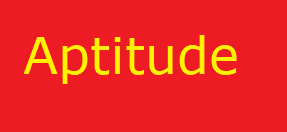Profit and Loss- Aptitude Questions and Answers | Online Profit and Loss MCQ Aptitude Test
| Quiz Name | Profit and Loss |
| Category | Online Aptitude Test |
| Number of Questions | 25 |
| Time | 30 Minutes |
| Exam Type | MCQ (Multiple Choice Questions) |
1. Alfred purchases an old scooter for Rs. 4700 and repairs it for Rs. 800. If he sells the scooter for Rs. 5800, his profit percentage is as follows
a. 4 4/7 %
b. 5 5/11 %
c. 10%
d. 12%
2. The selling price of x articles is equal to the cost price of 20 products. If the profit is 25%, then x has the following value:
a. 15
b. 16
c. 18
d. 25
3. Doubling the selling price triples the profit. Calculate the profit percentage.
a. 66 2/3
b. 100
c. 105 1/3
d. 120
4. The profit margin in one store is 320 percent of the cost. What percentage of the selling price is profit if the cost rises by 25% but the selling price remains constant?
a. 30%
b. 70%
c. 100%
d. 250%
5. A vendor paid a rupee for six toffees. How many rupees must he sell to make a 20% profit?
a. 3
b. 4
c. 5
d. 6
6. The proportion profit made on an article sold for Rs. 1920 is the same as the percentage loss made on the same article sold for Rs. 1280. What should the article be sold for in order to make a 25% profit?
a. Rs. 2000
b. Rs. 2200
c. Rs. 2400
d. Data inadequate
7. A shopkeeper anticipates a 22.5 percent increase in his cost price. What was his profit if his sale was Rs. 392 in a week?
a. Rs. 18.20
b. Rs. 70
c. Rs. 72
d. Rs. 88.25
8. A man purchases a cycle for Rs. 1400 and then sells it at a 15% loss. What is the cycle’s selling price?
a. Rs. 1090
b. Rs. 1160
c. Rs. 1190
d. Rs. 1202
9. At a cost of Rs. 375 a dozen, Sam purchased 20 dozens of toys. He made a Rs. 33 profit on each of them. What was his profit percentage?
a. 3.5
b. 4.5
c. 5.6
d. 6.5
10. Some products were purchased for Rs. 5 per article and sold for Rs. 6 per article. The gain percentage is:
a. 30%
b. 33 1/3%
c. 35%
d. 44%
11. There is a loss equal to the purchase price of 5 balls when selling 17 balls for Rs. 720. The price of a ball is as follows:
a. Rs. 45
b. Rs. 50
c. Rs. 55
d. Rs. 60
12. A land sold for Rs. 18,700 results in a 15% loss for the owner. What is the minimum price at which that plot must be sold in order to make a 15% profit?
a. Rs. 21,000
b. Rs. 22,500
c. Rs. 25,300
d. Rs. 25,800
13. One hundred oranges are purchased for Rs. 350 and sold for Rs. 48 a dozen. The profit or loss proportion is:
a. gain of 14 2/7 percent
b. An increase of 15%
c. 14 2 /7 percent reduction
d. a 15% reduction
14. A shopkeeper sells one transistor for Rs. 840 with a 20% profit and another for Rs. 960 with a 4% loss. His total gain or loss is calculated as follows:
a. 15/17% loss
b. 5 15/17% gain
c. 2/3% gain
d. None of these
15. A dealer offers a mixture of 26 kg of rice at Rs. 20 per kg and 30 kg of rice of a different kind at Rs. 36 per kg for Rs. 30 per kg. His profit margin is as follows:
a. No profit, no loss
b. 5%
c. 8%
d. 10%
16.A shopkeeper makes a 25% profit on some items by selling them at a lower price. What is the exact profit margin? Which of the following information from Statements I and II is/are required to determine the answer?
I. Sale price of the article II. Number of articles sold
a. Only I is necessary
b. Only II is necessary
c. Either I or II is necessary
d. Both I and II are necessary
17. A trader charges Rs. 250 for a set of toys. How much profit does he make as a percentage? Which of the following information from Statements I and II is/are required to determine the answer?I. The total number of toys sold.II. The cost of each toy.
a. Only I is necessary
b. Only II is necessary
c. Both I and II are necessary
d. Either I or II ins necessary
18. A man blends two types of rice (X and Y) and sells the result for Rs. 17 per kilogramme. Calculate his profit margin.
I. X is priced at Rs. 20 per kilogramme.
II. Y is priced at Rs. 13 per kilogramme.
a. I alone sufficient while II alone not sufficient to answer
b. II alone sufficient while I alone not sufficient to answer
c. Either I or II alone sufficient to answer
d. Both I and II are not sufficient to answer
19. How much profit was made by selling a product with a 20% profit margin?
I. There is a Rs. 40 gap between the cost and the selling price.
II. The selling price is 120% of the purchase price.
a. I alone sufficient while II alone not sufficient to answer
b. II alone sufficient while I alone not sufficient to answer
c. Either I or II alone sufficient to answer
d. Both I and II are not sufficient to answer
20. What is the profit percentage gained from selling an article?
I. A 5% discount is applied to the list price.
II. If no discount is granted, a profit of 20% is gained.
III. The products’ wholesale price is Rs. 5000.
a. Only I and II
b. Only II and III
c. Only I and III
d. None of these
21. What was the discount percentage that was given?
I.Selling an almirah for Rs. 12,350 yielded a profit of 23.5 percent.
II. The earned profit would have been 30% if there had been no discount.
III.The almirah cost Rs. 10,000 at the time of purchase.
a. Only I and II
b. Only II and III
c. Only I and III
d. None of these
22. What is the percentage profit that the shopkeeper makes on the items he sells?
I.The articles sold had a labelled price of 130 percent of the cost price.
II.Each piece has a cost of Rs. 550.
III.A 10% reduction on the labelled price was offered.
a. Only I
b. Only II
c. I and III
d. All the three are required




